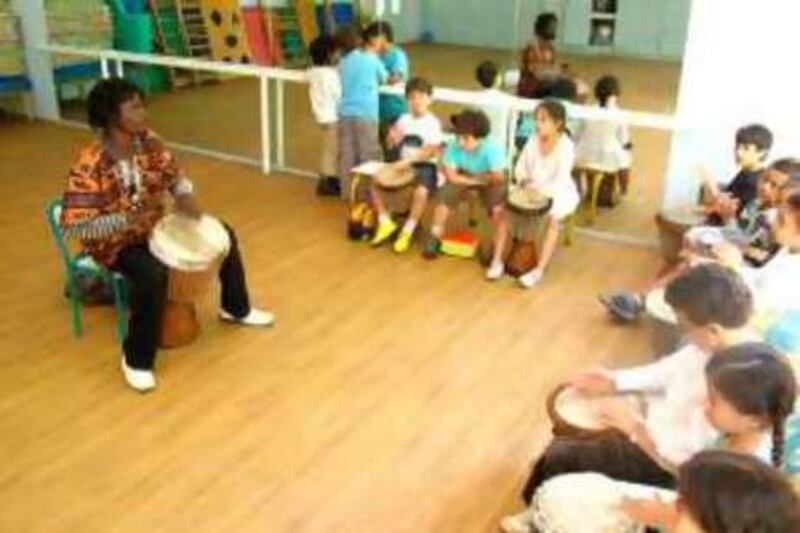CASABLANCA // Sitting opposite the children is a dreadlocked man from Senegal called Babacar Boyé, twice their height and clenching a skin drum between his knees. "Like this, children," he says, slapping the drum with his palms: Dum-dum, dum-dum, dum-dum, Da-dum.
The children pound their own drums in unison, and thunder reverberates into the courtyard of the École La Prairie, a private primary school in Casablanca. Mr Boyé, a drummer and dancer, is part of a recent influx into Morocco of sub-Saharan Africans. Some are migrants, others are students and a few are working. All have come to see the country as a step toward realising their ambitions. "In Senegal there are already a lot of professional musicians and dancers, and Europe is saturated with African artists," said Mr Boyé, 38, who came to Morocco in 2006. "This is virgin territory."
Now he is tapping into a new vogue in cosmopolitan cities such as Casablanca and Marrakech for all things African. "Schools hire me to help children discover black Africa through music and dance, and my dance troupe gets a lot of work at festivals and private soirées," he said. "Senegalese artists went to Europe in the 1930s; now that's repeating in Morocco." Interest in Africa is a relative novelty for the country, which has traditionally looked to the Arab world and Europe for cultural imports.
Arab armies invaded North Africa in the 7th century, introducing Islam and the Arabic language, while 20th century French colonialism helped shape modern Morocco, Algeria and Tunisia, leaving strong ties to Europe. Most of Africa lies beyond the barrier of the Sahara desert. In recent years thousands of sub-Saharan migrants have struggled across it en route to Europe via Spain. Thanks to tightened border controls by Spain, most get bottled up in Morocco.
"I never intended to stay here," said Moussa Brité, 28, a Guinean migrant mending shoes on a side-street in a working-class neighbourhood of Rabat, the capital. "My plan was to go to Spain." In 2007, Mr Brité left his farming village, paid traffickers for truck passage across the Sahara and slipped over the Algerian border into Morocco. "But now I can't make enough money to leave," he said. A man drew up beside Mr Brité and pulled off a shoe. "You see?" the man said. "It's tearing away from the sole just here."
Mr Brité took an awl from his toolkit and began punching holes in the leather for new thread. "I earn enough to eat," he said. "But there's not even enough left over to send my parents." Nobody knows how many sub-Saharan migrants are currently in Morocco. Recent estimates by United Nations agencies and non-governmental organisations (NGOs) range from about 3,000 to 10,000. Illegal migrants say that police sometimes drop them at the Algerian border. However, Morocco has rarely deported them to their home countries, said Rachid Badouli, the strategy and development director for the Orient-Occident Foundation, a Moroccan NGO supporting migrants. Morocco's foreign ministry did not respond to a request for comment.
Today migrant arrival rates are falling, Mr Badouli said. Meanwhile, nearly 3,000 migrants have gone home via a voluntary return programme begun in 2005 by the International Organization for Migration, co-ordinated with Moroccan authorities and funded mainly by European governments. However, as migrants leave, sub-Saharan students are increasingly arriving in search of better and cheaper education than their home countries offer.
Foreign students at Morocco's public universities have climbed from about 2,000 to 9,000 over the past decade, said Youssef Imari, the director of the state agency for international cooperation. "70 per cent are from sub-Saharan countries, and three quarters of those are getting a scholarship," he said. Students come for a chance of free tuition and the wide range of degrees, Mr Imari said, while Morocco is keen to strengthen ties with other African countries.
"Morocco is a major player in south-south cooperation, and accepting students is part of that," said Mr Imari. "The goal for Morocco is that students educated here return home and contribute to the development of their countries." "I applied to programmes in China, Algeria and Morocco," said Thierry, 28, a fifth-year Rwandan medical student coming out of an exam at Mohamed V University in Rabat last Wednesday, who did not give his surname. "At first I was really interested in China, but Morocco gave me the scholarship."
He wants to continue studying in Morocco to become a surgeon, but plans to return ultimately to Rwanda. "Why would I stay in this country, which has many doctors, when I can go home, where there aren't enough?" In Casablanca, Mr Boyé has other ideas. After the drum lesson at the École La Prairie, the children stampeded to the cafeteria and Mr Boyé retired to a patio with a cup of coffee to think about the future.
"African music, restaurants, art boutiques, dance troupes - there's a huge market here," he said. "I want to stay and develop all the projects in my head." jthorne@thenationial.ae





